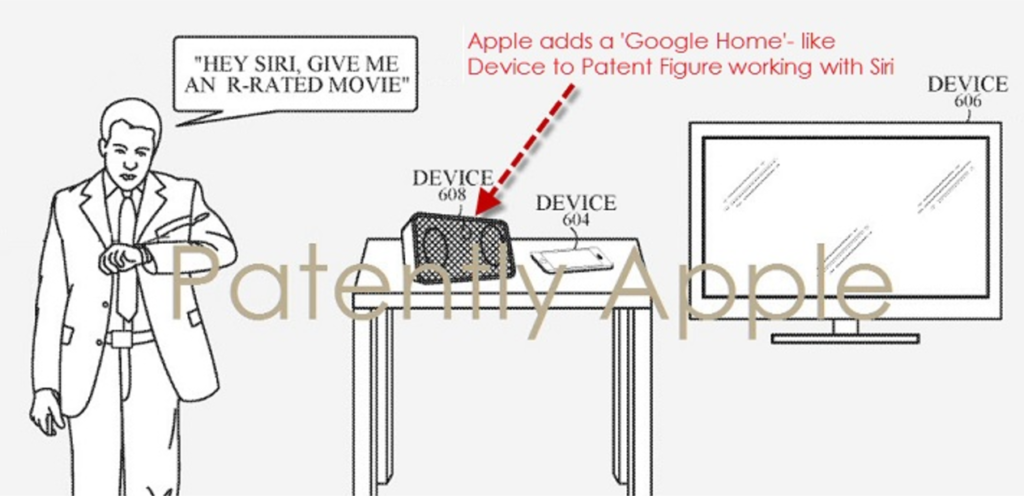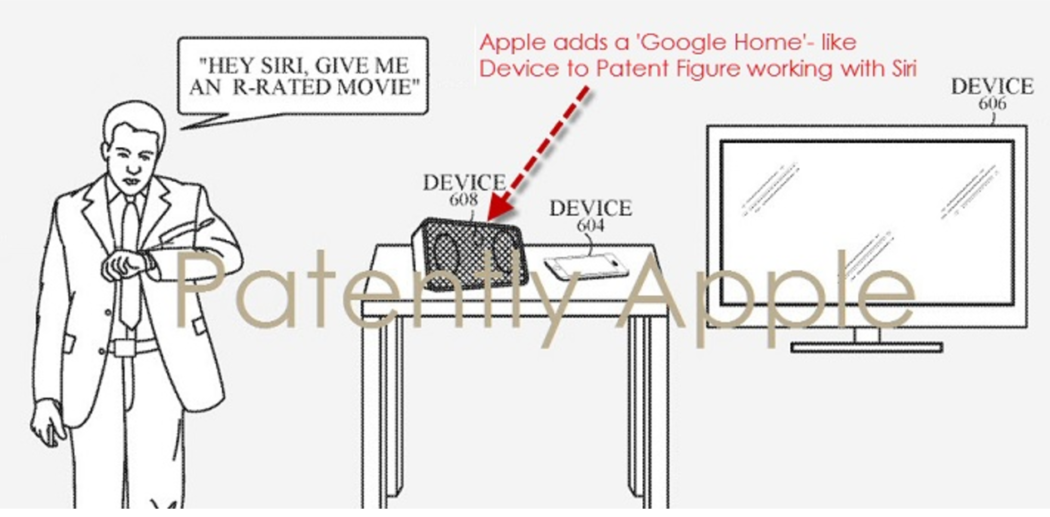Apple Patent Application Reveals Amazon Echo Competitor
Last week Voicebot reported on rumors that Apple is working on an Amazon Echo and Google Home competitor. The website Patently Apple has additional detail that it believes confirm a Siri-enabled smart speaker is in the works. It all comes down to the mysterious Device #608 in an Apple patent application that was published this year.

A Siri Traffic Cop
The overall patent focuses on Siri input and which microphone enabled device will be responsible for processing the spoken request.
Apple notes that once the spoken audio input has been sampled, one of the electronic devices may be identified as a first device used to determine the task based on the sampled audio input.
This appears similar to the Spatial Perception feature (see video demo here) rolled out in November for the Amazon Echo. This feature accounted for the fact that multiple Echo devices in a home may hear a user request due to the highly sensitive microphones. Originally, the Alexa voice assistant would respond on each device and create a cacophony of identical responses that weren’t audibly synchronized. Spatial perception eliminated that issue. It determines which device is closest to the user and only responds with content delivered to that device. The other devices go silent.
Beyond Spatial Perception to Device Preference Perception
Apple has an even greater potential issue with this situation because there are so many different Apple devices that have Siri enabled. The diagram shows an easily imagined scenario where a voice request to Siri could be heard simultaneously by a watch, television, iPhone and smart speaker. You don’t want Siri processing the same request from four different devices and responding to all of them at once. For example, you don’t want to request a movie and have it simultaneously play on a watch, phone and television. In this way, the Apple patent identifies a feature similar to the Amazon spatial perception solution.
However, Apple’s challenge goes even further in the scenario outlined. It considers that the response content payload might go to a different device than the one that processed the request because it was closest to the user’s voice input. In the Echo example, the spatial perception coordinates which is the nearest input device and then delivers the content payload to that device. The Apple patent example includes coordination on the nearest input device and the most appropriate output device. The watch might be closest microphone and therefore have precedence for handling the input request, but you don’t want the movie to play on your watch while you have a 4k large screen nearby. In this way, there is both spatial perception taking place to govern input precedence and device preference perception to govern output for the response content delivery.
New Device Includes Siri Input
According to the report, all of the devices in the patent application diagram are capable of both Siri input and response content output.
While Apple acknowledges the mysterious device #608 along with others like an iPhone, TV and Apple Watch, they never break out device #608 to describe it in any way. The closest they get is briefly mentioning a “Speaker Dock” later in the filing – though they never specifically link it back to device #608 to confirm it…Yet clearly we’re able to see that it’s a speaker-like device that could understand instructions for Siri, so it’s not a boom box.
This doesn’t confirm the imminent release of an Amazon Echo or Google Home competitor from Apple. The company has filed for many patents and not followed through with commercial products. However, it does provide insight into Apple’s thinking about how to coordinate a device ecosystem for users. It also reaffirms that Apple is thinking beyond the iPhone when it considers Siri’s future.
June Announcement Could be Critical for Apple Success
The timing would be good for an Apple smart speaker announcement at WWDC in June with a planned product release in the fall similar to Google’s approach with Google Home in 2016. The preview would cause some Apple fans to delay purchase of a competing device over the summer and provide time for developers to build applications for the new product prior to release. The smart speaker market only has about 10% penetration of U.S. households and is barely existent globally. That will change this year. A 2017 release would keep Apple in the game.
Follow @bretkinsella
Gartner Predicts 75% of US Households will Have Smart Speakers by 2020









